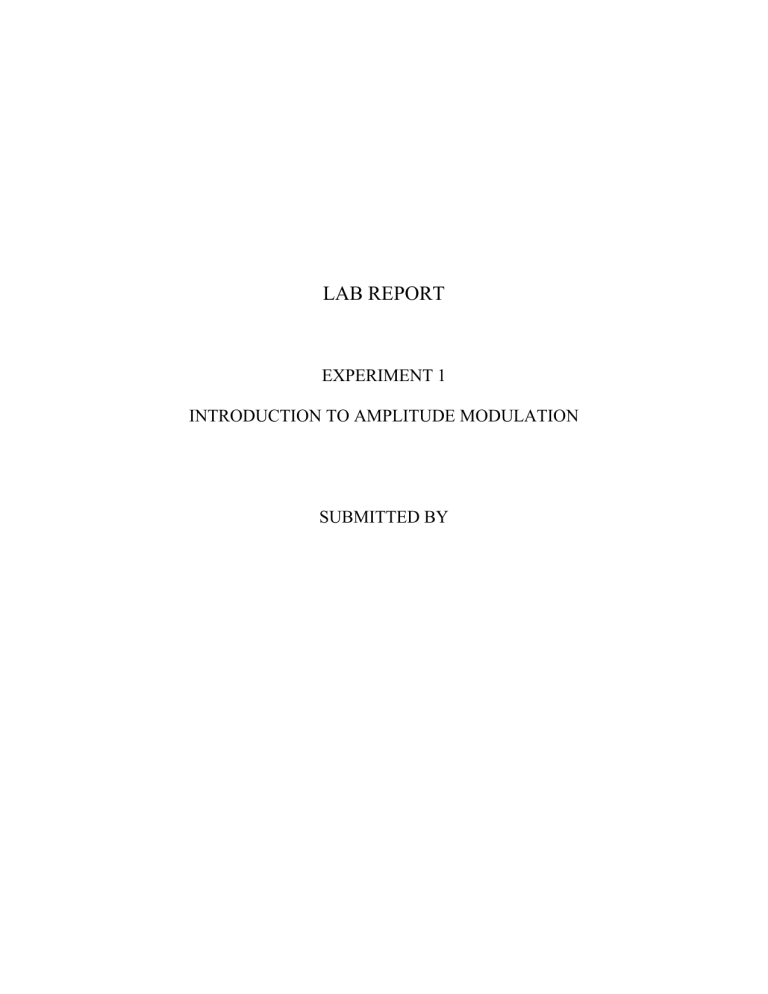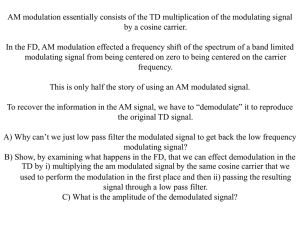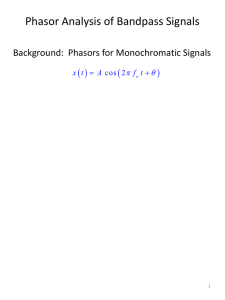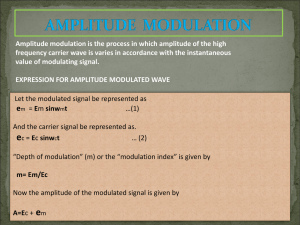Lab1 Introduction to SIMULINK and AM

LAB REPORT
EXPERIMENT 1
INTRODUCTION TO AMPLITUDE MODULATION
SUBMITTED BY
INTRODUCTION TO AMPLITUDE MODULATION
Purpose:
The objectives of this laboratory are:
1.
To introduce the spectrum analyzer as used in frequency domain analysis.
2.
To identify various types of linear modulated waveforms in time and frequency domain representations.
3.
To implement theoretically functional circuits using the Communications Module Design
System (CMDS).
Equipment List
1.
PC with Matlab and Simulink
I.
Spectrum Analyzer and Function Generator.
This section deals with looking at the spectrum of simple waves. We first look at the spectrum of a simple sine wave.
To Start Simulink: Start Matlab then type simulink on the command line. A Simulink Library
Window opens up as shown in figure 1.
Figure 1.1
Spectrum of a simple sine wave: - Figure 1.2 shows the design for viewing the spectrum of a simple sine wave.
Figure 1.2
Figure 1.3 shows the time-domain sine wave and the corresponding frequency domain is shown in figure 1.4. The frequency domain spectrum is obtained through a buffered-FFT scope, which comprises of a Fast Fourier Transform of 128 samples which also has a buffering of 64 of them in one frame. The property block of the B-FFT is also displayed in figure 1.5.
Figure 1.5
This is the property box of the Spectrum Analyzer
From the property box of the B-FFT scope the axis properties can be changed and the Line properties can be changed. The line properties are not shown in the above. The Frequency range can be changed by using the frequency range pop down menu and so can be the y-axis the amplitude scaling be changed to either real magnitude or the dB (log of magnitude) scale. The upper limit can be specified as shown by the Min and Max Y-limits edit box. The sampling time in this case has been set to 1/5000.
Note: The sampling frequency of the B-FFT scope should match with the sampling time of the input time signal.
Also as indicated above the FFT is taken for 128 points and buffered with half of them for an overlap.
Calculating the Power: The power can be calculated by squaring the value of the voltage of the spectrum analyzer.
Note: The signal analyzer if chosen with half the scale, the spectrum is the single-sided analyzer, so the power in the spectrum is the total power.
Similar operations can be done for other waveforms – like the square wave, triangular. These signals can be generated from the signal generator block.
II Waveform Multiplication (Modulation)
The equation y = k m cos 2 (2
(1,000)t) was implemented as in fig. 1B peak to peak voltage of the input and output signal of the multiplier was measured. Then km can be computed as k m
Vpp ( 2 kHz )
* 2
Vpp ( 1 kHz )
0 .
5 / 2 * 2
0 .
5
The spectrum of the output when km=1 was shown below.
The following figure demonstrates the waveform multiplication. A sine wave of 1kHz is generated using a sine wave generator and multiplied with a replica signal. The input signal and the output are shown in figures.
The input signal as generated by the sine wave is shown in figure.
The output of the multiplier is shown in figure and the spectral output is shown in figure.
It can be seen that the output of the multiplier in time domain is basically a sine wave but doesn’t have the negetive sides. Since they get cancelled out in the multiplication.
\
The spectral output of the spectrum is shown below. It can be seen that there are two side components in spectrum. The components at fc + fm and –(fc + fm) can be seen along with a central impulse.
If a DC component was present in the input waveform, then y = k m
*(cos(2
(1,000)t) + Vdc) 2
= k m
*(cos 2 (2
(1,000)t) + 2cos(2
(1000)t*Vdc + Vdc 2 )
The effect of adding a dc component to the input has the overall effect of raising the amplitude of the 2KHz component and decreases the 2KHz component. However, for a value of Vdc = 0.1V, the 1KHz component reduces and for any other increase in the Vdc value, the 1KHz component increases.
1
0.9
0.8
0.7
0.6
0.5
0.4
0.3
0.2
0.1
0
-2500 -2000 -1500 -1000 -500 0
Frequncy
500 1000 1500 2000 2500
Double Side-Band Suppressed Carrier Modulation:
Figure shows the implementation of a DSB-SC signal. The Signals are at 1kHz and
10kHz.
The output is shown below. It can be seen that the output consists of just two side bands at +(fc + fm) and the other at –(fc + fm) , i.e. at 9kHz and 11kHz.
By multiplying the carrier signal and the message signal, we achieve modulation.
Y*m(t) = [k m cos (2
1000t)* cos (2
10000t)]
We observe the output to have no 10KHz component i.e., the carrier is not present. The output contains a band at 9KHz (fc-fm) and a band at 11KHz (fc+fm). Thus we observe a double side band suppressed carrier. All the transmitted power is in the 2 sidebands.
Effect of Variations in Modulating and Carrier frequencies on DSB – SC signal.
By varying the carrier and message signal frequencies, we observe that the 2 sidebands move according to the equation fc
fm.
Now, using a square wave as modulating signal, we see that DSBSC is still achieved.
The output from spectrum analyzer was slightly different from the theoretical output. In the result from the spectrum analyzer, there is a small peak at frequency = 10kHz (the carrier frequency) and other 2 peak at 0 and 1000 Hz. This may caused by the incorrectly calibrated multiplier.
Next, the changes to the waveform parameters have been made and then the outputs have were observed. And here are the changes that have been made
1
0.9
0.8
0.7
0.6
0.5
0.4
0.3
0.2
0.1
0
0 2000 4000 6000
Frequncy
8000 10000 12000
1 Vary the 10kHz carrier frequency
Expected result: Both sidebands are expected to be centered on the new carrier frequency.
The real result is as expected.
2 Vary the modulating frequency and amplitude
Expected result: The position of the sidebands would have been changed when the modulating frequency is changed. The sidebands would move further from the carrier frequency if the modulating frequency is increased. The peak of the sidebands would be higher if the amplitude of the modulating signal increases
The result of the experiment is as expected.
3 Change the carrier signal to a square wave.
Expected result: There would be the high peaks of the modulating signal around the carrier frequency. Expect for a small peak of the carrier because the time average of the square wave does not equal to zero. The waveform of the signal is expected to be square wave which the amplitude is the sine wave at 1khz.
The result of the experiment is as expected
4 Change the modulating signal to a square wave
Expected result: It is likely to see the spectrum of the square wave in the both sidebands around the carrier frequency. The output waveform would be the sine wave, which the amplitude equals to the amplitude of the square wave.
The result of the experiment is as expected.
Amplitude Modulation :
This experiment is the amplitude modulation for modulation index a = 1 and 0.5.
From the equation of the AM y
k m
( 1
a
cos( 2
( 1000 ) t )
cos( 2
( 10000 ) t
The representation of the signal in both time-domain and frequency domain when k m
=1 for a=1 and a=0.5 were found to be as shown in figures.
The experimental set up for generating an AM signal looks like this: -
Spectrum of AM waveform when a=1
1.5
1
0.5
0
0 2000 4000 6000
Frequncy
8000 10000 12000
The
The input waveform 50% modulated is shown in figure
The output spectrum is shown below
It must be noted here that the A.M signal can be converted into a DSB-SC signal by making the constant = 0.
The waveforms at various levels of modulation are shown in the following figures.
2
AM waveform when a=1
1.5
1.5
1
0.5
0
-0.5
-1
-1.5
0
1
0.5
0
-0.5
-1
-1.5
-2
0 0.5
0.5
1
1 1.5
time (sec)
1.5
time (sec)
2
AM waveform when a=0.5
2
2.5
2.5
x 10
-3
3 x 10
-3
3
1.5
1
0.5
0
0 2000
Spectrum of AM waveform when a=0.5
4000 6000
Frequncy
8000 10000 12000
The results from the experiment were shown. The results from the experiment are pretty much the same as in the theoretical ones except there are 2 other peaks at 0 and 1000kHz. This is the same as earlier experiment. The cause of this problem is probably the multiplier.
Two Tone Modulation
The last experiment in this section is the two tone modulation. In this experiment, the 2kHz signal had been added to the modulating signal in the above experiment. Theoretically, the representation of the modulated signal in time-domain and frequency domain would have been as in the figure below. In the figure, 1kHz and 2kHz signals were modulated with 10kHz carrier.
3
2
1
0
-1
-2
Two tone AM waveform when a=1
-3
0 0.5
1 1.5
time (sec)
2 2.5
x 10
-3
3
The experimental setup is shown below.
The two-tone waveform before being amplitude modulated.
The two-tone signal is amplitude modulated using the same block model discussed in the previous section. The output spectrum is shown in figure.. In this case the signals of 1kHz and
2kHz are modulated by a 10kHz carrier. The output spectrum is shown in figure
The result from the experiment was shown. The highest peak is at the carrier frequency as in the theoretical result. But there were differences on the sidebands. In the figure from MATLAB, both frequencies in the sidebands have the same magnitude, but from the experiment, the components at 9000Hz and 11000Hz have higher magnitude than the components at 8000Hz and 12000 Hz.
There’re also many small peaks of about 1000Hz apart in the experiment result. This might come from the incorrectly calibrated multiplier.
The final experiment in this section is to change the carrier frequency and the modulating frequency. When the carrier frequency increases, the spectrum of the modulated signal is expected to have the two sidebands centered at the new carrier frequency. And when one of the two modulating signals changes in frequency, the spectrum of the output signal should have two components move away from their original positions according to the change in frequency. The result from the experiment was shown. Both change in carrier frequency and modulating frequency is shown.
IV Single Sideband Modulation.
The DSB-SC signal occupies twice the space necessary than required for holding the information. Therefore, by chopping off one part of the DSBSC, more signal transmission can be achieved. Filtering the DSBSC gives the output as either a LSB(Lower side band) or a
USB(Upper side band).The simulation set up for the SSB signal is shown in figure below
The output is going to be a side band. The output of this setup before and after the Filtering is shown in figures .. and figure .. It can be noted that the output of the SSB signal before filtering has the higher order frequency components which are eliminated by the filter.
Instead of using a filter, the same task can be achieved by using a phase shifter and summer in conjunction with the existing circuit. By operating the summer as an adder causes the USB to be produced. If the summer is operated as an inverter, then, the LSB will be retained.
Without filtering
After filtering the higher order components are removed and we get a wave form of the form shown in figure
Phase Shift SSB Modulation
Figure shows the experimental setup for the Phase Shift SSB Modulation. The signal consists of four input sine waves.
The output of the difference block in both the time domain and the frequency domain is of importance to us.
Figure A represents the output waveform when the sign is +- and the one on the right gives the wave form for ++. They represent the lower and the upper-side bands respectively. The output spectrum is shown in figure
Conclusion:
We learnt how to operate the spectrum analyzer, oscilloscope and the function generator to generate and view different waveforms. We also performed the different modulation schemes –
DSBSC, AM and SSB. We conclude that the DSBSC modulating system is better as no power is lost in the carrier. SSB permits more of the information to be transmitted over the same channel by chopping off the duplicate sideband.
Appendix 1
PRE LAB
INTRODUCTION TO AMPLITUDE MODULATION
I Sketch the time and frequency domain representations(magnitude only) of the following:
A. Cos 2
ft f = 1kHz
Sine Wave
SCOPE
Spectrum
Analyzer
The time and frequency domain of the input signal is shown as below.
3
0
-1
2
1
-2
-3
-5 -4 -3 -2 -1 0
Time domain
1
2000
1500
1000
500
0
0 500 1000 subplot(2,1,1); x = -5:0.001:5; t = 0:1/4000:1; time = cos(2*3.14*1000*t); y1 = cos(2*3.14*1000*x); plot(x,y1) axis([-5 5 -3 3]); grid on zoom on
1500 2000
Freq domain
2500
2
3000
3 4
3500
5
4000
xlabel( 'Time domain' ); ylabel( 'Amplitude' );
% now create a frequency vector for the x-axis and plot the magnitude and phase subplot(2,1,2); fre = abs(fft(time)); f = (0:length(fre) - 1)'*4000/length(fre); plot(f,fre);
%axis([0 1 -1 10]);
%axis([0 0.75 -2 2]); grid on zoom on xlabel( 'Freq domain' ); ylabel( 'Amplitude' );
B. Square wave period = 1msec, amplitude = 1v
SCOPE
Spectrum
Square Wave
Analyzer
CODE:
subplot(2,1,1); x = -5:0.001:5;
Fs = 399; t = 0:1/Fs:1; time = SQUARE(2*3.14*1000*t); y1 = SQUARE(2*3.14*1000*x); plot(x,y1) axis([-5 5 -3 3]); grid on zoom on xlabel( 'Time domain' ); ylabel( 'Amplitude' );
% now create a frequency vector for the x-axis and plot the magnitude and phase subplot(2,1,2); fre = abs(fft(time)); f = (0:length(fre) - 1)'*Fs/length(fre); plot(f,fre);
%axis([0 1 -1 10]);
%axis([0 0.75 -2 2]);
grid on zoom on xlabel( 'Freq domain' ); ylabel( 'Amplitude' );
3
0
-1
2
1
-2
-3
-5 -4 -3 -2
300
-1 0
Time domain
1
200
100
2 3 4 5
0
0 50 100 150 200 250 300 350 400
Freq domain
C. Cos
2
(2
ft) f = 1kHz
subplot(2,1,1); x = -5:0.001:5;
Fs = 1699; t = 0:1/Fs:1; time = cos(2*3.14*1000*t).*cos(2*3.14*1000*t); y1 = cos(2*3.14*1000*x).*cos(2*3.14*1000*x); plot(x,y1) axis([-5 5 -3 3]); grid on zoom on xlabel( 'Time domain' ); ylabel( 'Amplitude' );
% now create a frequency vector for the x-axis and plot the magnitude and phase subplot(2,1,2); fre = abs(fft(time)); f = (0:length(fre) - 1)'*Fs/length(fre); plot(f,fre);
%axis([0 1 -1 10]);
%axis([0 0.75 -2 2]); grid on zoom on xlabel( 'Freq domain' ); ylabel( 'Amplitude' );
Cos2(2pift)
3
2
1
0
-1
-2
-3
-5 -4 -3 -2 -1 0
Time domain
1 2 3 4 5
200
150
100
50
0
0 50 100 150
Freq domain
200 250 300
II A carrier Cos 2
(5000)t is modulated by a single tone Cos 2
(1000)t.
The time and freq domain representation are shown.
A.
Double side-band – suppressed carrier modulation
1
0
-1
0
1
0
-1
0
1
0
-1
0
50
0.1
0.2
0.3
0.4
0.5
0.6
0.7
0.8
0.9
0.1
0.1
0.2
0.3
0.4
0.2
0.3
0.4
0.5
0.6
0.7
0.8
0.5
0.6
0.7
0.8
0.9
0.9
1
1
1
0
0 10 20 30 40 50
Freq domain
60 70 80 90
% Modulating the single tone message signal.
Ts = 199; subplot(4,1,1); t = 0:1/Ts:1; m = cos(2*3.14*1000*t); plot(t,m); grid on zoom on
% plot of the carrier signal subplot(4,1,2); c = cos(2*3.14*5000*t); plot(t,c); grid on zoom on
% plot of the DSB signal with Suppresed carrier intime domain subplot(4,1,3); d = m.*c; plot(t,d); grid on zoom on
% freq. domain of the DSB signal. subplot(4,1,4); fre = abs(fft(d)); f = (0:length(fre) - 1)'*Ts/length(fre); plot(f,fre);
%axis([0 1 -1 10]); axis([0 100 0 50]); grid on
100
zoom on xlabel( 'Freq domain' ); ylabel( 'Amplitude' );
B. 100% AM modulation ( modulation index = 1)
% Modulating the single tone message signal.
Ts = 199;
K = 1; a = 1; subplot(4,1,1); t = -1:1/Ts:1; m = cos(2*3.14*1000*t); plot(t,m); grid on zoom on
% plot of the carrier signal subplot(4,1,2); c = cos(2*3.14*5000*t); plot(t,c); grid on zoom on
% plot of the DSB signal with Suppresed carrier intime domain subplot(4,1,3); d = (K + a*m).*c; plot(t,d); grid on zoom on
% freq. domain of the DSB signal. subplot(4,1,4); fre = abs(fft(d)); f = (0:length(fre) - 1)'*4000/length(fre); plot(f,fre);
%axis([0 1 -1 10]);
%axis([0 0.75 -2 2]); grid on zoom on xlabel( 'Freq domain' ); ylabel( 'Amplitude' );
%axis([0 2000 0 205]);
1
0
-1
-1
1
-0.8
-0.6
-0.4
-0.2
0 0.2
0.4
0.6
0.8
1
0
-1
-1
2
0
-0.8
-0.6
-0.4
-0.2
0 0.2
0.4
0.6
0.8
1
-2
-1
200
100
-0.8
-0.6
-0.4
-0.2
0 0.2
0.4
0.6
0.8
1
0
0 100 200 300 400 500 600 700 800 900 1000
Freq domain
C.
50% AM modulation (modulation index = 0.5)
Ts = 199;
K = 1; a = 1; subplot(4,1,1); t = -1:1/Ts:1; m = cos(2*3.14*1000*t); plot(t,m); grid on zoom on
% plot of the carrier signal subplot(4,1,2); c = cos(2*3.14*5000*t); plot(t,c); grid on zoom on
% plot of the DSB signal with Suppresed carrier intime domain subplot(4,1,3); d = (K + a*m).*c; plot(t,d); grid on zoom on
% freq. domain of the DSB signal. subplot(4,1,4); fre = abs(fft(d)); f = (0:length(fre) - 1)'*4000/length(fre); plot(f,fre);
%axis([0 1 -1 10]);
%axis([0 0.75 -2 2]); grid on zoom on xlabel( 'Freq domain' ); ylabel( 'Amplitude' );
%axis([0 2000 0 205]);
1
0
-1
-1
1
0
-0.8
-0.6
-0.4
-0.2
0 0.2
0.4
0.6
0.8
1
-1
-1
2
0
-0.8
-0.6
-0.4
-0.2
0 0.2
0.4
0.6
0.8
1
-2
-1
200
100
-0.8
-0.6
-0.4
-0.2
0 0.2
0.4
0.6
0.8
1
0
0 100 200 300 400 500 600 700 800 900 1000
Freq domain
D.
Single Side Band Modulation (lower side band)
The single side band waveform can be obtained by filtering the DSB signal. Filtering out the lower side band give the upper side – i.e. the SSB signal with the upper side bands.
So by low passing the DSB signal we get the lower side band of the SSB signal.
1
0
-1
-1
1
-0.8
-0.6
-0.4
-0.2
0 0.2
0.4
0.6
0.8
1
0
-1
-1
2
0
-0.8
-0.6
-0.4
-0.2
0 0.2
0.4
0.6
0.8
1
-2
-1
200
100
-0.8
-0.6
-0.4
-0.2
0 0.2
0.4
0.6
0.8
1
0
0 200 400 600 800 1000 1200 1400 1600 1800 2000
Freq domain
E.
By changing the modulating signal in frequency the distance between the carrier and the side bands change as shown in figure for a increase and decrease in the frequency of the modulating signal.
Increasing the frequency f = 4000Hz.
1
0
-1
-1
1
0
-1
-1
2
0
-0.8
-0.6
-0.4
-0.2
-0.8
-0.6
-0.4
-0.2
0
0
0.2
0.2
0.4
0.4
0.6
0.6
0.8
0.8
1
1
-2
-1
200
100
-0.8
-0.6
-0.4
-0.2
0 0.2
0.4
0.6
0.8
1
0
0 200 400 600 800 1000 1200 1400 1600 1800 2000
Freq domain
Decreasing the Frequency f = 990Hz
III Two Tone (1kHz and 2kHz) modulating a carrier of 5kHz
.
A.
Double side band suppressed carrier
1
0
-1
-1
1
0
-1
-1
2
-0.8
-0.6
-0.4
-0.2
-0.8
-0.6
-0.4
-0.2
0
0
0.2
0.2
0.4
0.4
0.6
0.6
0.8
0.8
1
1
0
-2
-1
200
100
-0.8
-0.6
-0.4
-0.2
0 0.2
0.4
0.6
0.8
1
0
0 200 400 600 800 1000 1200 1400 1600 1800 2000
Freq domain
B.
100% AM modulation ( modulation index = 1)
% Modulating the single tone message signal.
Ts = 199;
K = 1; a = 1s; subplot(4,1,1); t = -1:1/Ts:1; m = cos(2*3.14*1000*t) + cos(2*3.14*2000*t); plot(t,m); title( '2 tone Double side band - suppressed carrier modulation' ); xlabel( 'Time' ); ylabel( 'Amplitude' ); grid on zoom on
% plot of the carrier signal subplot(4,1,2); c = cos(2*3.14*5000*t); plot(t,c); grid on zoom on
% plot of the DSB signal with Suppresed carrier intime domain
subplot(4,1,3); d = (K + a*m).*c; plot(t,d); grid on zoom on
% freq. domain of the DSB signal. subplot(4,1,4); fre = abs(fft(d)); f = (0:length(fre) - 1)'*4000/length(fre); plot(f,fre);
%axis([0 1 -1 10]);
%axis([0 0.75 -2 2]); grid on zoom on xlabel( 'Freq domain' ); ylabel( 'Amplitude' );
%axis([0 2000 0 205]);
2 tone 100% AM modulation with modulation index = 1
2
0
-2
-1
1
0
-0.8
-0.6
-0.4
-0.2
0
Time
0.2
0.4
0.6
0.8
-5
-1
200
100
-1
-1
5
0
-0.8
-0.8
-0.6
-0.6
-0.4
-0.4
-0.2
-0.2
0
0
0.2
0.2
0.4
0.4
0.6
0.6
0.8
0.8
1
1
1
0
0 500 1000 1500 2000
Freq domain
2500 3000 3500 4000
C.50% AM modulation (modulation index = 0.5)
2 tone 50% AM Modulation modulaton index = 0.5
2
0
-2
-1
1
-0.8
-0.6
-0.4
-0.2
0
Time
0.2
0.4
0.6
0.8
1
0
-1
-1
2
0
-0.8
-0.6
-0.4
-0.2
0 0.2
0.4
0.6
0.8
1
-2
-1
200
100
-0.8
-0.6
-0.4
-0.2
0 0.2
0.4
0.6
0.8
1
0
0 200 400 600 800 1000 1200 1400 1600 1800 2000
Freq domain
D. Single Side Band Modulation (lower side band)
2 tone Single side band Modulation (lower side band)
2
-1
5
-1
0
0
-2
-1
1
0
-0.8
-0.6
-0.4
-0.2
0
Time
0.2
-0.8
-0.6
-0.4
-0.2
0 0.2
0.4
0.4
0.6
0.6
0.8
0.8
1
1
-5
-1
200
100
-0.8
-0.6
-0.4
-0.2
0 0.2
0.4
0.6
0.8
1
0
0 200 400 600 800 1000 1200 1400 1600 1800 2000
Freq domain
E.
By changing the modulating signal in frequency the distance between the carrier and the side bands change as shown in figure for a increase and decrease in the frequency of the modulating signal.
Increasing the frequency f = 3000Hz and 4000Hz.
2 tone Effect of chaging the frequency of modulating signal
2
0
-2
1
-1 -0.8
-0.6
-0.4
-0.2
0
Time
0.2
0.4
0.6
0.8
1
0
-1
-1
2
0
-0.8
-0.6
-0.4
-0.2
0 0.2
0.4
0.6
0.8
1
-2
-1
200
100
-0.8
-0.6
-0.4
-0.2
0 0.2
0.4
0.6
0.8
1
0
0 200 400 600 800 1000 1200 1400 1600 1800 2000
Freq domain
Decreasing Frequency F1 = 990Hz and F2 = 3900Hz
2 tone Effect of chaging the frequency of modulating signal
2
0
-2
-1
1
0
-0.8
-0.6
-0.4
-0.2
0
Time
0.2
0.4
0.6
0.8
1
-2
-1
200
100
0
0
-1
-1
2
0
-0.8
-0.6
-0.4
-0.2
-0.8
-0.6
-0.4
-0.2
0
0
0.2
0.2
0.4
0.4
0.6
0.6
0.8
0.8
1
1
200 400 600 800 1000 1200 1400 1600 1800 2000
Freq domain








